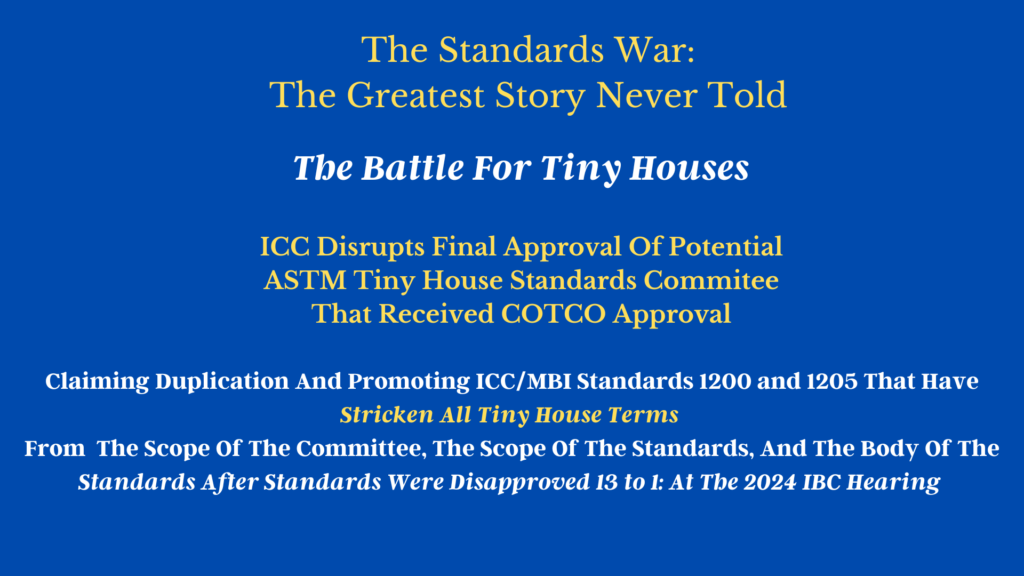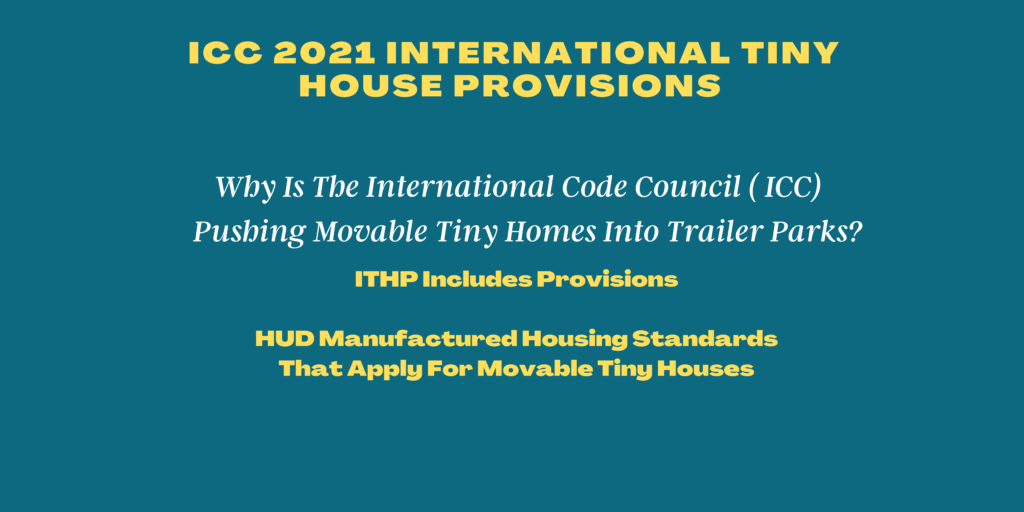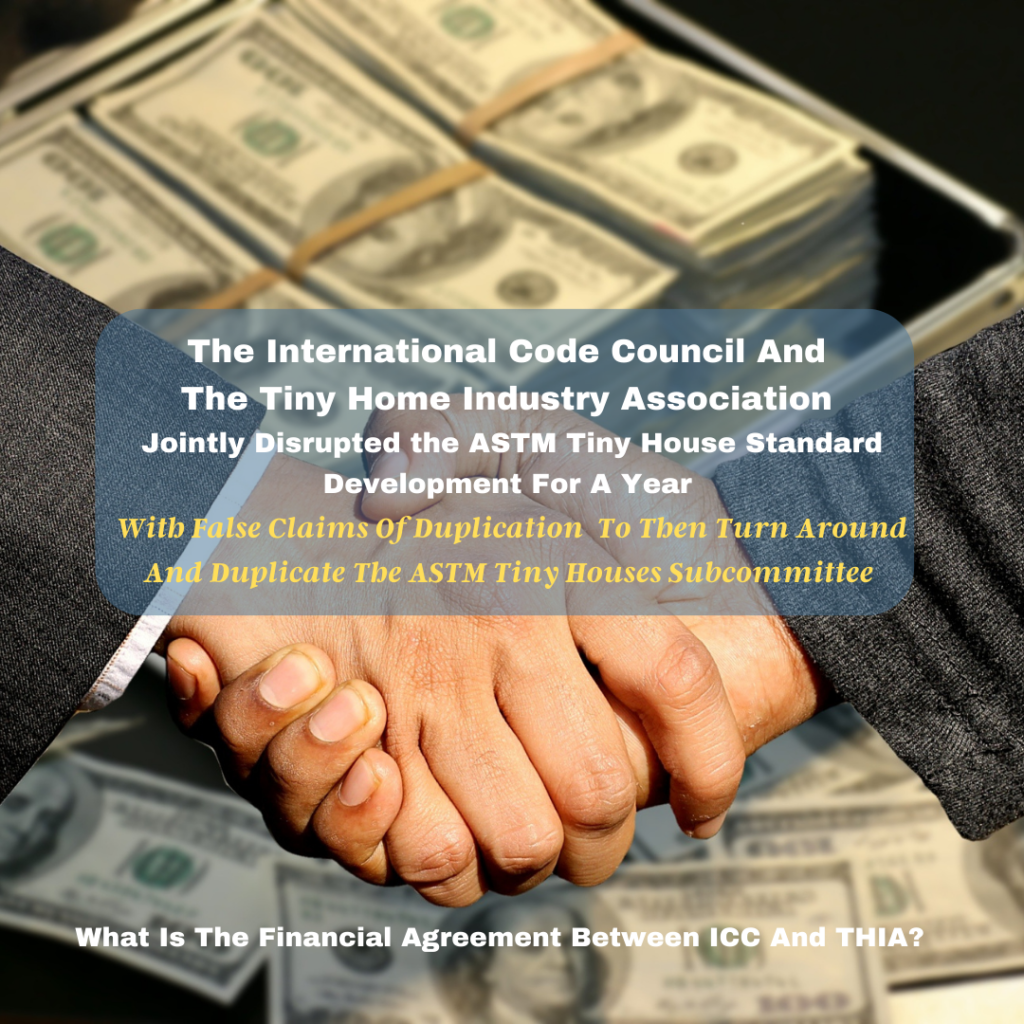New ICCTHIA Standard Competes With Existing ASTM Tiny House Standards Development
On April 4, 2023, ICC issued a press release stating -”Washington, D.C. – The International Code Council and the Tiny Home Industry Association (THIA) will collaborate to update the existing provisions on tiny houses contained in the International Residential Code® (IRC), Appendix AQ through the standards development process. The content of ICC/THIA Standard 1215: Design, Construction, Inspection and Regulation of Tiny Houses for Permanent Occupancy will continue to cover tiny houses used for permanent occupancy on a foundation or on wheels as addressed in the IRC. The standard will be developed through the Code Council’s ANSI-consensus procedures, requiring essential engagement from all industry stakeholders and allowing for an in-depth examination of technical or emerging issues. ”
The Scope
This standard will provide minimum requirements for the design, construction, inspection, certification and regulatory compliance of tiny houses used for permanent occupancy to assure public safety, sustainability and resilience. The standard will include: consensus definitions for tiny houses and related terminology; prescriptive and performance based compliance methods for tiny house permanent foundations and chassis; and plan review, inspection and certification requirements for tiny houses constructed on-site and off-site. The standard will address tiny houses built on a foundation and those with wheels and a permanent chassis intended for permanent occupancy. The 2021 International Residential Code (including Appendix AQ), and ICC/MBI Standards 1200 and 1205 will serve as the initial base documents with references to other existing standards. The standard will be written in mandatory code-intended language to support use by manufacturers and adoption by jurisdictions globally. This standard will not address tiny houses used for temporary or seasonal occupancy, tiny houses installed on temporary foundations, or tiny house community development or microgrids.
Amended Pins April 21, 2023
ICC (International Code Council)
Karl Aittaniemi <ka*********@*****fe.org> | 4051 Flossmoor Road | Country Club Hills, IL 60478 www.iccsafe.org
New Standard
BSR/ICC/THIA 1215-202x, Design, Construction, Inspection and Regulation of Tiny Houses for Permanent Occupancy (new standard)
Stakeholders: Tiny house builders, building code officials, building product manufacturers, architects, engineers, third-party plan review and inspection agencies, consumer advocates, homeowners and renters.
Project Need: Tiny houses are growing in popularity as communities look to address affordable housing issues and home buyers are looking for new housing options. This standard will codify existing requirements for the design, construction, inspection and certification of tiny houses used as permanent dwellings into a single standard and address identified gaps in available requirements for foundations and chassis. The 2021 International Residential Code (including Appendix AQ), and ICC/MBI Standards 1200 and 1205 will serve as the initial base documents with references to other existing standards.
Interest Categories: Manufacturer, Builder, Standards Promulgator/Testing Laboratory, User, Utility, Consumer, Public Segment, Government Regulator, Insurance
This standard will provide minimum requirements for the design, construction, inspection, certification, and regulatory compliance of tiny houses used for permanent occupancy to assure public safety, sustainability, and resilience. The standard will include: consensus definitions for tiny houses and related terminology; prescriptive and performance based compliance methods for tiny house foundations and chassis; and plan review, inspection and certification requirements for tiny houses constructed onsite and off-site. The standard will address tiny houses built on a foundation and those with wheels and a permanent chassis intended for permanent occupancy. The 2021 International Residential Code (including Appendix AQ), and ICC/MBI Standards 1200 and 1205 will serve as the initial base documents with references to other existing standards. The standard will be written in mandatory code- intended language to support use by manufacturers and adoption by jurisdictions globally. This standard will not address tiny houses used for temporary or seasonal occupancy, or tiny house community development or microgrids.
Source ANSI Standards Action Pins Notification April 21, 2023
The ICC News Release States Their New Standard Complements ASTM
”The standard complements the work of ASTM’s recently established E06.26 Subcommittee on Tiny Houses by combining existing criteria for tiny houses used for permanent occupancy into a single, referenceable location. ”
In truth, the new ICC/THIA standard does not complement ASTM, it competes with the ASTM Tiny House subcommittee E06.26.
ICC And THIA Disrupted The ASTM Tiny House Initiative For A Year
During A Housing Crisis

We spent a year of continued delays for the ASTM Tiny House initiative that had a primary focus to develop a new standard for tiny houses on wheels, first with THIA and then with ICC with their false claims of duplication, and that nothing more was needed for tiny houses because the IRC and HUD and Appendix AQ Tiny House, along with ICC/MBI 1200 and 1205, everything was addressed for tiny houses and that there was not a need for any new standards to be developed, except for foundations for tiny houses.
Note: All Tiny Home Terms Were Deleted From Standards 1CC/MBI 1200 And 1205 After The disappoval At The IBC Hearing with the notion that tiny homes were ‘ inclusive. ‘
Learn More
Tiny Home Terms Deleted From ICC Standards
ASTM’s Answer To THIA
While we were stalled, ICC and THIA came out with two joint publications.
Learn More
Tiny House Model Legislation
2021 International Tiny House Provisions ( Both ICC And THIA Sell This Publication)
The Publication Was Back-Dated To 2021
Note: It is important to note that the publication was back-dated to 2021 and the standards that are being promoted, ICCMB1 1200 and 1205 are American standards. They have removed all tiny house terminology after the disapproval at the 2024 hearing with the notion that tiny houses are ”inclusive”. The publication came out 6 days before the ICC/ASTM COTCO hearing addressing the duplication claim of ICC that objected to the COTCO approval of a new ASTM tiny house committee to develop and maintain standards specific to tiny houses. The main basis of the duplication claim was based on the two ICC/MBI standards 1200 ad 1205 that have removed all tiny house terms from the scope of the committee, the scope of the standards, and the body of the standards.

The ICC News Release Lists The Names Of The Individuals That Disrupted ASTM
”Ryan Colker, Code Council Vice President of Innovation, David Tompos, President of ICC-NTA, and Brad Wiseman, CEO and Board Chairman of THIA, are members of this ASTM subcommittee and will work alongside other members to ensure that the Code Council and ASTM efforts avoid overlap and complement each other, in addition to providing consistency and clarity for tiny house builders, code officials and municipalities on corresponding codes and standards. ”
These are the very individuals that worked against the ASTM tiny house initiative and the name and scope of the ICC/THIA standard are already completely overlapping and will only compete with each other, not complement.
ICC Did Not Allow Tiny Homes On Wheels In The Initial Proposal Of Appendix Q Tiny House That Was Approved For Inclusion To The 2018 IRC.
ASTM is the appropriate standard developer to develop standards for tiny houses on wheels. Every time movable provisions are presented to ICC, it is turned down. Two examples:
From Andrew Morrison, Co-Author Of Appendix Q Tiny House
I had to make some last minute changes to the proposed code language to remove the word “moveable” from my original proposal entitled “Movable Tiny Houses.” Unfortunately, the head of the ICC code approval process said that he would not accept the proposal as written because he believed it was what they call in the industry a “hijack” of the original proposal.
After many conversations and emails with the official, I decided to amend the proposal so that he would allow it to move forward. After all, when he said “if you keep the moveable details in there, I will throw the whole thing out” it became crystal clear what my options were.
Source Washington Tiny House Association: So What Exactly Is Tiny House Appendix Q?
The IBC Hearing Regarding ICC/MBI 1200 And 1205
Micah Chappell City Of Seattle, State Building Code Council was the first to make a motion to disapprove the standards, he stated;
‘’ IRC Appendix Q is not required to be adopted by states or it is not required to be used, and tiny house is not defined in the IBC. This proposal would take the tiny house, which is just a dwelling unit, and take the review and application requirements of that dwelling unit and push it to a standard.
I do not agree with that. When we are talking about tiny houses and Appendix Q, they are very specific, but there are two criteria here that are not defined, a tiny house on wheels, or a tiny house like the other modular buildings where it is possibly driven in and then craned onto a foundation. So blanket items for tiny houses, I do not agree with. ‘’
Summary
THIA and ICC have jointly tried to Monopolize And Monetize the tiny house industry for their sole benefit and we were stalled with the ASTM tiny house initiative for a year, with their false claim of duplication and that everything had been achieved for tiny houses between the IRC, HUD, and the 2 standards ICC/MBI 1200 and 1205 that was a declared as a ‘robust standard development for tiny houses,‘ although the tiny house terms had been deleted 13 to 1 after the IBC hearing disapproval.
THIA and ICC then co-published the Model Legislation and 2021 International Tiny House Provisions ( That THIA Can Sell) partly to promote ICC/MBI 1200 and 1205 ( which adds the tiny house terms back. ). In between, ICC and THIA halted the ASTM opportunity in the Colorado rule-making.
I was told ICC is not going to LET ASTM create a residential standard, warned that I was close to a libel suit, and was even told in an email that they were thinking about restricting our use of AQ and the HUD code. THIA included 7 votes against the formation of an ASTM committee at the organizational meeting to present the proposal to COTCO and 6 were on their own board. It is obvious that only ICC and THIA feel they have a say in the tiny house industry and it does not look good that both organizations worked against the progress of the tiny house industry, co-authored publications, promoting the standards and codes that ICC published while trying to restrict trade, a new method of construction, interrupted another standard developer, told ASTM and our stakeholders that there was no need for the new standards we were proposing, just to turn around and duplicate our exact standards that we are going to develop.
That is a very closed loop. All roads leading to Rome- A Monopoly.
We Are Advocates For Housing
I and many others have joined the ASTM Tiny House subcommittee to progress tiny houses to be recognized a a viable housing solution. We fairly won every vote and milestone and followed all the required processes including the ANSI Essential Requirements For Due Process, that include: openness, lack of dominance,balance, coordination and harmonization, notification of standards development, consideration of views and objections, and consensus votes.
ASTM International is one of the largest ANSI accredited standard developers in the world and they provide a platform for fair processes for volunteers of a industry to come together and write consensus documents and to be the ” architects of their own future, not its victims, ”as so famously quoted by Buckminster Fuller. 150 countries can participate and already we have over 140 members with exceptional expertise to contribute the developing much needed standards for tiny houses. Every voice matters!
Closing Thoughts
I am not officially affiliated with ASTM. My comments and my opinions are my own. I have continually sought inclusiveness, unity, collaboration, and communication to unite the tiny house industry. Sadly, the industry is divided which is unnecessary, because our goals are the same.
The relationship with ICC and THIA should be closely investigated and questioned because of the conflicts of interest which include;
- Written by a subsidiary of ICC that is stating tiny houses must comply with standards ICC developed
- Authored by the founder of NTA, now called ICC NTA, that was the chair of the ICC Off-Site And Modular Construction Standards Committee
- The Author was also the task group leader for Accreditation that wrote requirements at the maximum level, instead of the minimum leaving out one of the most popular 3rd parties that
certify tiny houses. - The Author is also on the board of THIA
- The Co-Author is also on the board of THIA
- The Co-Author was also the only company that represented tiny houses at the ICC Off-Site Committee
Co-Branding An ICC Standard With THIA Is Exercising Dominant Authority
Co-branding the ICC standard with THIA is already a conflict before the standard is even written and is a conflict with the ANSI Essential Requirements for a lack of dominance as stated;
The standards development process shall not be dominated by any single interest category, individual or organization. Dominance means a position or exercise of dominant authority, leadership, or influence by reason of superior leverage, strength, or representation to the exclusion of fair and equitable consideration of other viewpoints.
Filing A Pins Complaint To ICC And ANSI
For anyone that will be affected by the development of this new standard, you will have 30 days to object.
File Your Complaint To Karl Aittaniemi at ka*********@*****fe.org and copy ANSI at ps*@**si.org
ICC (International Code Council)
Karl Aittaniemi <ka*********@*****fe.org> | 4051 Flossmoor Road | Country Club Hills, IL 60478 www.iccsafe.org New Standard
BSR/ICC/THIA 1215-202x, Design, Construction and Regulation of Tiny Houses for Permanent Occupancy (new standard)
Stakeholders: Tiny house builders, building code officials, building product manufacturers, architects, engineers, third-party plan review and inspection agencies, consumer advocates, homeowners and renters.
Project Need: Tiny houses are growing in popularity as communities look to address affordable housing issues and homebuyers are looking for new housing options. This standard will codify existing requirements for the design, construction, and certification of tiny houses used as permanent dwellings into a single standard and address identified gaps in available requirements for permanent foundations and chassis. The 2021 International Residential Code (including Appendix AQ), and ICC/MBI Standards 1200 and 1205 will serve as the initial base documents with references to other existing standards.
Interest Categories: Manufacturer, Builder, Standards Promulgator/Testing Laboratory, User, Utility, Consumer, Public Segment, Government Regulator, Insurance.
Scope: This standard will provide minimum requirements for the design, construction, inspection, certification and regulatory compliance of tiny houses used for permanent occupancy to assure public safety, sustainability and resilience. The standard will include: consensus definitions for tiny houses and related terminology; prescriptive and performance-based compliance methods for tiny house permanent foundations and chassis; and plan review, inspection and certification requirements for tiny houses constructed on-site and off-site. The standard will address tiny houses built on a foundation and those with wheels and a permanent chassis intended for permanent occupancy. The 2021 International Residential Code (including Appendix AQ), and ICC/MBI Standards 1200 and 1205 will serve as the initial base documents with references to other existing standards. The standard will be written in mandatory code-intended language to support use by manufacturers and adoption by jurisdictions globally. This standard will not address tiny houses used for temporary or seasonal occupancy, tiny houses installed on temporary foundations, or tiny house community development or microgrids.

